Discovering United States Gold Coins
Whether you buy them at a coin shop, or find them using a metal detector, the information here may help to authenticate your U.S. Gold Coins.
Liberty Gold Dollar Type I
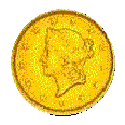
-
Type I Liberty $1, Weight 1.672 grams .900 Gold, .100 Copper, 13 mm Diameter

Type I Liberty $1, Weight 1.672 grams .900 Gold, .100 Copper, 13 mm Diameter
Indian Gold Dollar Type II
-
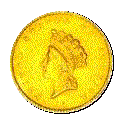
-
Type II Indian $1, Weight 1.672 grams .900 Gold, .100 Copper, 15 mm Diameter
Type II Indian $1, Weight 1.672 grams .900 Gold, .100 Copper, 15 mm Diameter
Indian Gold Dollar Type III
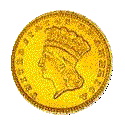
- Type III Indian $1 Weight 1.672 grams .900 Gold, .100 Copper, 15 mm Diameter

Liberty & Indian $1 Gold
These $1 coins minted between 1849 and 1889 were designed by James B. Longacre. They contain .04837 oz. of gold. Smaller than a dime, these coins were lost from pockets and purses because they would slip through small holes in either.
Liberty Gold $2.50 “Quarter Eagle”
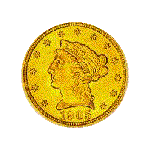
-
Liberty $2.50, Weight 4.18 grams .900 Gold, .100 Copper, 18 mm Diameter Reeded Edge

Liberty $2.50, Weight 4.18 grams .900 Gold, .100 Copper, 18 mm Diameter Reeded Edge
Indian Gold $2.50 “Quarter Eagle”
-
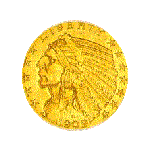
-
Indian $2.50, Weight 4.18 grams .900 Gold, .100 Copper, 18 mm Diameter Reeded Edge
Indian $2.50, Weight 4.18 grams .900 Gold, .100 Copper, 18 mm Diameter Reeded Edge
These $2.50 coins minted between 1840 and 1929 were designed by Christian Gobrecht (Liberty), and Bela Lyon Pratt (Indian) The $2.50 Indian Head gold coins were only struck for 13 years (1908-1915, and 1925-1929). They both contain .12094 oz. of gold.
$3 ‘Indian Princess’
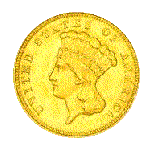
-
$3 Indian Princess, Weight 5.015 grams .900 Gold, .100 Copper, 20.5 mm Diameter Reeded Edge

$3 Indian Princess, Weight 5.015 grams .900 Gold, .100 Copper, 20.5 mm Diameter Reeded Edge
The $3 “Indian Princess” gold coin containing .14512 oz. gold, was designed by James B. Longacre. Not a popular coin or denomination, it was “kept”, rather than circulated by the public.
$4 “Stella” Gold
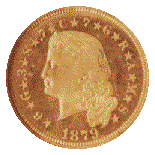
-
$4 Stella, EXTREMELY RARE

$4 Stella, EXTREMELY RARE
The rare $4 “Stella”, so named for the star on the reverse, had two varieties: The flowing hair type, designed by Charles E. Barber, and the coiled hair type by George T. Morgan, designer of the famous “silver dollar” of 1879-1921. Only [700+] Flowing Hair $4 Stellas were minted in 1879, and just 8 “Coiled Hair” coins from 1880 are known to exist ! The coins were minted in 93% gold, 7% copper/silver. There were also patterns minted in gold, aluminum, copper and white metal.
$5 Liberty Gold Half Eagle
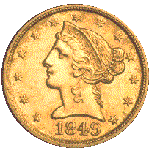
-
$5 Liberty, Weight 8.359 grams .900 Gold, .100 Copper, 21.6 mm Diameter Reeded Edge

$5 Liberty, Weight 8.359 grams .900 Gold, .100 Copper, 21.6 mm Diameter Reeded Edge
$5 Indian Gold Half Eagle
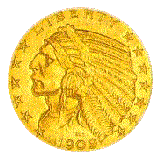
-
$5 Indian, Weight 8.359 grams .900 Gold, .100 Copper, 21.6 mm Diameter Reeded Edge
The $5 Liberty Half Eagle, designed by Christian Gobrecht, was struck at all seven mints, the “No Motto” variety (1839-1865) being the rarest.The $5 Indian Half Eagle was designed by Bela Lyon Pratt with its unique “incused” or recessed design similar to his 2½ dollar coin. Both $5 coins contain .24187 oz. gold.
$10 Liberty Gold Eagle
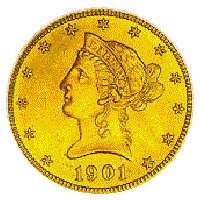
-
$10 Liberty, Weight 16.718 grams .900 Gold, .100 Copper, 27 mm Diameter Reeded Edge
$10 Indian Gold Eagle

-
$10 Indian, Weight 16.718 grams .900 Gold, .100 Copper, 27 mm Diameter 46 Raised Stars (1907-1911), 48 Raised Stars (1912-1933) on Edge
The $10 Liberty Eagle design was by Christian Gobrecht, the Indian designed by Augustus Saint-Gaudens. Both coins contain .48375 oz. of gold. The edge of the Indian coin was distinguished by 46 raised stars representing the States of the Union, with 48 stars after 1911.
$20 Liberty Gold Double Eagle
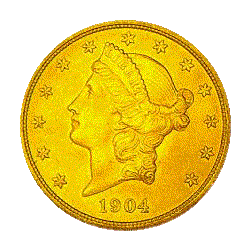
-
$20 Liberty, Weight 33.436 grams .900 Gold, .100 Copper, 34 mm Diameter Reeded Edge
$20 Saint-Gaudens Gold Double Eagle

-
$20 Saint-Gaudens, Weight 33.436 grams .900 Gold, .100 Copper, 34 mm Diameter E*PLURIBUS*UNUM on Edge



 Posted by jporter852
Posted by jporter852